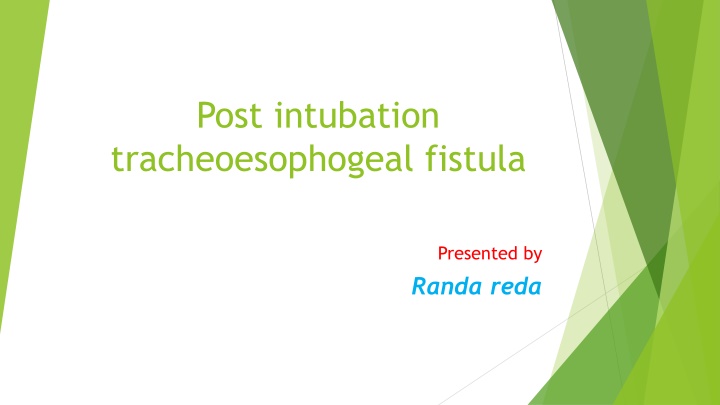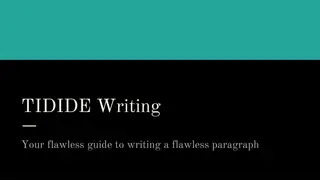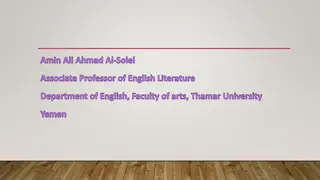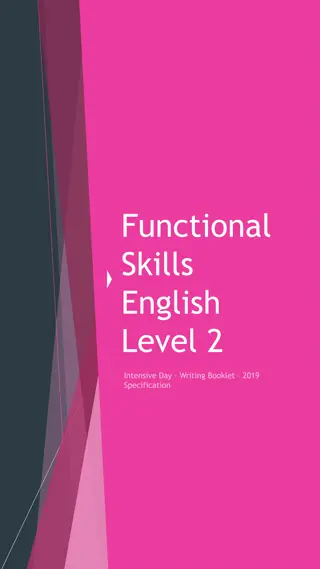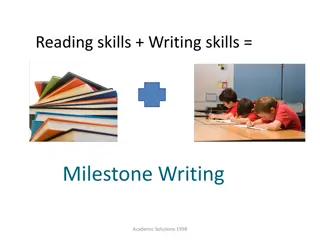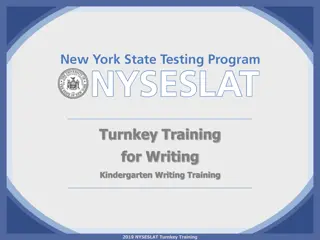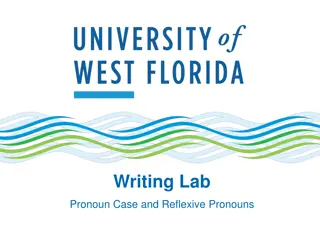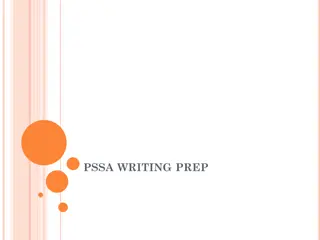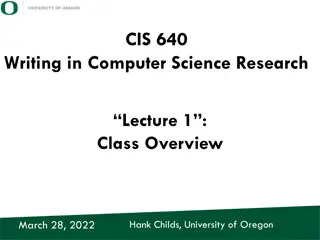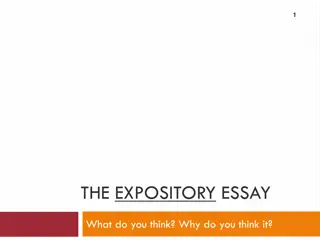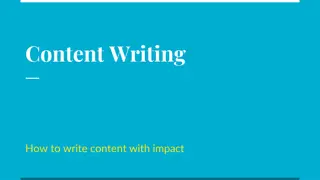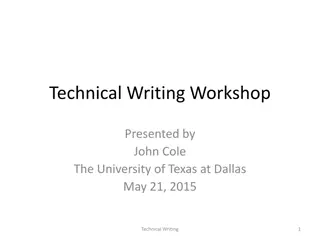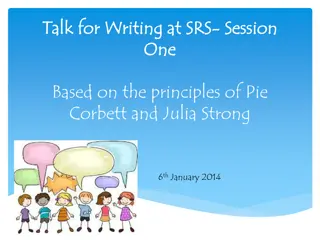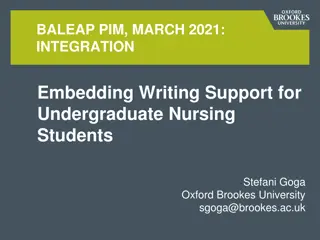Mastering Informational Writing Skills
Enhance writing abilities with a focus on informative/explanatory texts. Explore key standards, learning targets, and engaging instructional activities, including reading benchmarks and writing assessments. Gain insights into structuring content, citing evidence, analyzing text interactions, and more. Develop skills in organizing ideas, using relevant facts, and creating cohesive text transitions.
Uploaded on Feb 28, 2025 | 0 Views
Download Presentation

Please find below an Image/Link to download the presentation.
The content on the website is provided AS IS for your information and personal use only. It may not be sold, licensed, or shared on other websites without obtaining consent from the author.If you encounter any issues during the download, it is possible that the publisher has removed the file from their server.
You are allowed to download the files provided on this website for personal or commercial use, subject to the condition that they are used lawfully. All files are the property of their respective owners.
The content on the website is provided AS IS for your information and personal use only. It may not be sold, licensed, or shared on other websites without obtaining consent from the author.
E N D
Presentation Transcript
Post intubation tracheoesophogeal fistula Presented by Randa reda
Introduction Esophagotracheal and esophagobronchial fistulas represent a pathological entity characterized by the presence of an abnormal communication between the tracheobronchial tree and the digestive tract - the esophagus. The consequences of permanent pulmonary contamination by food containing and digestive secretions can be very serious, with a possible fatal evolution. The first publications of a post-intubation esophagotracheal fistula are attributed to d' Avignon (1956) and Mounier - Kuhn (1958), and the first prospective study on the incidence and pathogenesis of post-tracheostomy and mechanical ventilation tracheal injury belongs to Andrews and Pearson [3]. In this prospective study, over a period of two years, that included 220 tracheostomized, critical patients (of whom 103 survived), two esophagotracheal fistulas developed. Currently, prolonged intubation is the main cause of benign tracheoesophageal fistula, although the introduction of high volume and low pressure endotracheal tube cuffs reduced the incidence of this complication. The incidence is between 0.3 and 3% in patients with prolonged mechanical ventilation . Tracheostomy does not seem to decrease the risk of developing post-intubation esophagotracheal fistula.
Pathogenesis Pathogenic mechanism is represented by the chronic trauma of prolonged tracheal intubation. The pressure resulted from the hyper-inflated endotracheal tube cuff on the posterior membranous wall, most often against a rigid nasogastric tube, produces ischemic necrosis that also affects the anterior wall of the esophagus, the result being an abnormal communication. Usually, in these situations, tracheal stenosis co-exist Very rarely, fistulas may result from bedsores lying at the tip of a rear-angulated cannula, along with the pressure from a transesophageal rigid probe. In this case, circumferential tracheal injury is missing. If the esophagotracheal fistula is located at the same level with the stoma, the pathogenic mechanism might be a direct tracheoesophageal injury during tracheostomy. A number of risk factors such as the following are mentioned: high airway pressure during mechanical ventilation, excessive mobility of the endotracheal tube, prolonged time of intubation, steroids treatment, insulin-dependent diabetes, poor nutritional status, chronic hypoxia in cardiopulmonary diseases, prolonged episodes of hypotension, chronic anemia, sepsis and gastro-esophageal reflux. Payne [5] reported associated risk factors: female gender and old age.
Pathology The localization of post-intubation fistula is high, in the cranial half of the trachea and, in the case of patients with tracheostomy, 1-2 cm distal from the stoma, at the site of the endotracheal cuff. Left axis deviation of the cervical and upper thoracic esophagus determines the location of the fistula at the left edge of the membranous wall. The dimensions are variable, but most of the fistulas are giant (4-5 cm), over the entire width of the posterior wall being destroyed. The process of fistula formation is long. Perilesional inflammation binds the tracheal and esophageal walls, so mediastinitis never occurs. Spontaneous healing of the fistula is illusory because the edges are epithelialized. In many cases, fistula formation is associated with circumferential tracheal destruction produced by the same mechanism of ischemic necrosis. This association requires tracheal resection and termino terminal anastomosis
Clinical presentation The clinical manifestations differ, depending on the patient's respiratory status. In ventilatory assisted patients: - air leaks even with hiperinflated cuff - abdominal distension associated with ventilation rhythmated air-liquid sounds - tracheobronchial contamination with food and digestive secretions (gastric juice, bile) - broncho-pulmonary suppuration In normal breathing and oral feeding patients: - ONO`s sign (deglutition followed by cough in the absence of other swallowing disorders) - expectoration of food remains and bile coloured secretions - bronchopulmonary suppuration with respiratory deterioration Due to their localization (2 cm distal to the stoma), post-tracheostomy fistulas can be observed transstomally after decannulation. In a cannulated and orally fed patient, the ingestion of methylene blue dye-solution could be a diagnostic (the dye is coughed through the cannula).
Imagistic studies Chest X-rays can show a dilatation of the esophagus (distal to the fistula) and of the stomach . It may highlight the hyper-transparency caused by overinflated endotracheal cuff with a diameter greater than 35 mm (indirect sign of fistula) . It can also reveal the radiological signs of secondary pulmonary abscesses. The esophagram is especially useful where endoscopic examination is not possible. Ingestion of a small amount of contrast agent usually reveals the site of the fistula and the abnormal route of the contrast substance into the tracheobronchial tree. A contrast substance that produces a minimal bronchial inflammation should be used.
Imagistic studies If a tracheoesophageal fistula is suspected, the most accurate investigation and one that should always be done is bronchoscopy. It identifies the site (in relation with the glottis, cricoid cartilage, carina and with a possible tracheal stoma), the size of the fistula and the length of the normal airway segments. Bronchoscopy also reveals the possible association of circumferential tracheal destruction. The esophageal lumen and a nasogastric tube can be observed through the parietal defect. In case of doubt of the diagnosis methylene blue solution may be instilled on the nasal-esophageal probe Esophagoscopy has fewer chances to highlight the fistula (especially when its dimensions are reduced), which may be hidden by the longitudinal mucosal folds. EBUS-combined echo-endoscopic tracheobronchial investigation provides information about the status of peritracheal tissues. CT scan examination is not required for the diagnosis of tracheoesophageal fistula, but it can confirm the presence of it, the possible associated stenosis and the bronchopulmonary suppuration
Therapeutic management Treatment is difficult because of the many deficits of patients: poor respiratory status (pulmonary infection, mechanical ventilation), severe biological condition, poor nutritional status and the presence of associated diseases (cardiovascular, neurological). Optimal time for surgery is established when the patient no longer requires mechanical ventilation and his biological status is improved . Mechanical ventilated patients are not candidates for surgery because of the negative effect of tracheal intubation on anastomosis and esophageal suture, with a very high risk of complications. In these cases, conservative treatment is chosen. The general prognosis will be taken into account. A bad short-term prognosis excludes surgery
Conservative treatment is sometimes used as a preparation prior to surgery. The goals are the cease of contamination of the tracheobronchial tree with digestive contain, the resolution of bronchial-pulmonary suppuration, the improvement of the patient`s nutritional status and the weaning from ventilator. If a nasogastric tube is present, it will be extracted and, in conscious patients, oral feeding will be stopped. A drainage gastrostomy and a feeding jejunostomy will be installed. This can be done by laparotomy, or by minimally invasive surgery (laparoscopic jejunostomy or percutaneous endoscopic combined technique). The patient will be held with the body elevated to 45 degrees at least a few hours after meals. Anti-secretory and prokinetic medication will be associated to prevent gastro-esophageal reflux. The cuff of the tracheostomy cannula will be placed distally to the fistula under endoscopic control and will be inflated with the minimum amount of air that seals the trachea. Repeated bronchial aspiration will be performed. Esophageal diversion is almost never necessary. The small amount of saliva, which may contaminate the tracheobronchial tree, is not usually a problem. Atropine type medication in purposes of minimizing saliva secretion can be administered . In exceptional circumstances, when esophageal diversion is necessary, cervical-esophageal fistula will be terminal and not in continuity (dividing the esophagus immediately proximal to the fistula and the distal end of the esophagus will be closed). Continuous aspiration by gastrostomy is enough to prevent gastroesophageal reflux.
Conservative treatment The energetic necessities of an immobilized patient are of about 20-25 kcal / kg / day and 30-35 kcal / kg / day in patients with physical activity. Parenteral nutrition will be temporary used only in addition to the enteral intake, which is mandatory. The healing of the pulmonary suppuration is achieved by antibiotic therapy and respiratory physiotherapy. Literature mentions sporadic successes by using endoscopic treatment. Clerf et al. showed that it is possible to close the fistula by endoscopic cauterization with small crystals of sodium hydroxide Other endoscopic solutions have been proposed, such as minimal excision of the edges and closure of the esophageal orifice with fibrin glue or clips . Tracheal and/or esophageal stent implantation have been used for the endoscopic treatment of the fistula in patients with surgical contraindication. Tracheal stenting can be taken into account in the following situations: proximal lesion (an esophageal stent in this location would interfere with the upper esophageal sphincter competency), the association of tracheal stenosis due to the destruction of the cartilage, after the previous placement of an endoesophageal stent without sealing of the fistula or if the esophageal stenting is impossible. Also, if there is any concern about an esophageal stent that may reduce (after expanding) the tracheal lumen, the stent will be placed in the trachea. The stent`s length should exceed 2-3 cm cranially and caudally the limits of the fistula.
Conservative treatment Rigid silicone stents, very effective in palliation of neoplastic stenosis, have several disadvantages for benign tracheal stenosis: high rate of migration, small inner diameter due to the thickness of the silicone wall, the absence of re-epithelialization and the lack of collapse during cough (which leads to difficulties in the clearance of the secretions). In the 1990s, self- expanding metal stents have replaced rigid plastic prostheses in an attempt to resolve these deficiencies. However, metal stents also have some drawbacks: they can cause tracheal wall perforation with possible vascular lesions, can form exuberant granulomatous tissue with stenosis. Partially covered metal stents are a newer acquisition. They develop a less granular reaction and can also be easier extracted. An attractive option for the future could be the biodegradable stents, which have lower migration rates and do not need to be extracted . Recently (available in the U.S. since 2003), self- expanding plastic stents were introduced. In the case of stenting a tracheoesophageal fistula, a covered stent that can be extracted after 3-4 weeks should be used. After the stent extraction, the residual presence of the fistula is checked. If it is not completely healed, another covered stent will be placed for another 4-6 weeks. In 35% of the cases, the tracheoesophageal fistula recurs.
Surgery The objective is to close the fistula with a separate suture of the fistulous orifices. Any area of lung parenchyma with irreversible damage must be resected in the same operative session. In case of simultaneous tracheal stenosis, segmental tracheal resection and termino terminal anastomosis will be associated. In both situations, most authors recommend the interposition of viable tissue between the two sutures, although there are opinions that this is not mandatory. The operation will be performed in a single session as described by Grillo et al. in 1976 . This approach is used by other authors . In some cases, the tracheal stenosis may be too long and cannot be resected. After fistula repair, the trachea will be stented with a permanent T- tube. There are sporadic communications of more extensive surgery in such cases. Gallan et al. reported a case of eso tracheal fistula associated with a 6.5 cm length tracheal stenosis, in which the authors conducted a membranous wall tracheoplasty by using an esophageal wall after they excluded the esophagus and performed an esophageal - gastric by-pass with colic graft
Surgery Trans-thoracic approach Tracheal fistula closure without resection Cervical or cervico-mediastinal approach
Thank you Thank you
